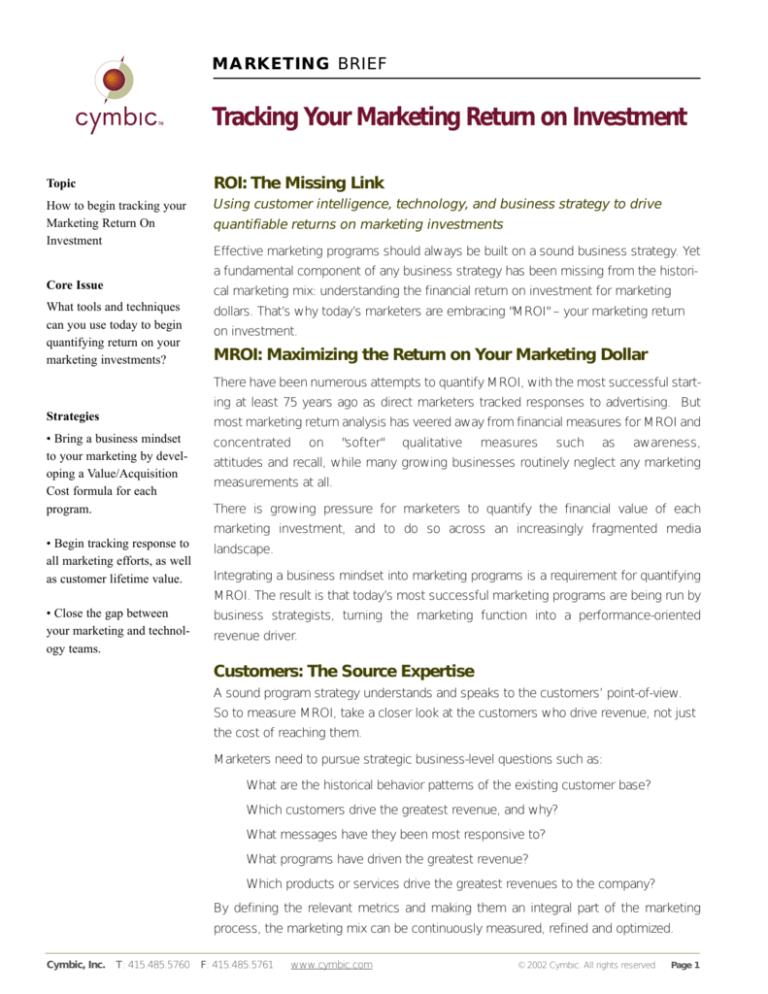
MARKETING BRIEF
Tracking Your Marketing Return on Investment
Topic
ROI: The Missing Link
How to begin tracking your
Marketing Return On
Investment
Using customer intelligence, technology, and business strategy to drive
quantifiable returns on marketing investments
Effective marketing programs should always be built on a sound business strategy. Yet
a fundamental component of any business strategy has been missing from the histori-
Core Issue
cal marketing mix: understanding the financial return on investment for marketing
What tools and techniques
can you use today to begin
quantifying return on your
marketing investments?
dollars. That’s why today’s marketers are embracing "MROI" – your marketing return
on investment.
MROI: Maximizing the Return on Your Marketing Dollar
There have been numerous attempts to quantify MROI, with the most successful starting at least 75 years ago as direct marketers tracked responses to advertising. But
Strategies
most marketing return analysis has veered away from financial measures for MROI and
• Bring a business mindset
to your marketing by developing a Value/Acquisition
Cost formula for each
program.
concentrated
on
"softer"
qualitative
measures
such
as
awareness,
attitudes and recall, while many growing businesses routinely neglect any marketing
measurements at all.
There is growing pressure for marketers to quantify the financial value of each
marketing investment, and to do so across an increasingly fragmented media
• Begin tracking response to
all marketing efforts, as well
as customer lifetime value.
landscape.
Integrating a business mindset into marketing programs is a requirement for quantifying
MROI. The result is that today’s most successful marketing programs are being run by
• Close the gap between
your marketing and technology teams.
business strategists, turning the marketing function into a performance-oriented
revenue driver.
Customers: The Source Expertise
A sound program strategy understands and speaks to the customers’ point-of-view.
So to measure MROI, take a closer look at the customers who drive revenue, not just
the cost of reaching them.
Marketers need to pursue strategic business-level questions such as:
• What are the historical behavior patterns of the existing customer base?
• Which customers drive the greatest revenue, and why?
• What messages have they been most responsive to?
• What programs have driven the greatest revenue?
• Which products or services drive the greatest revenues to the company?
By defining the relevant metrics and making them an integral part of the marketing
process, the marketing mix can be continuously measured, refined and optimized.
Cymbic, Inc.
T: 415.485.5760
F: 415.485.5761
www.cymbic.com
© 2002 Cymbic. All rights reserved.
Page 1
MARKETING BRIEF
Tactics
It is crucial that these metrics are tied to specific program objectives and expected finan-
• Begin tracking the cost of
customer acquisition. How
much does a lead cost? How
much does it cost to close a
deal? Apply the same
method to each channel you
use to compare performance.
cial benefits, and are used as part of an ongoing decision support cycle.
By focusing on the customers who drive revenue back to the company, marketers can
get answers to the right questions. If you know your customer value and true acquisition
cost, decisions are better informed and more accurate.
Leveraging Technology
Whether you’re a marketer for a large enterprise or a venture-backed startup, demands
• Invest in technologies that
enable you to track customer
behavior—even on a simple
Web site—andthat which
increases the interactions
between you and your
customer.
• Use updated marketing
research techniques like Web
site surveys on your own site
to stay close to customer
perceptions and needs.
for marketing accountability are growing every quarter. The most dramatic example can
be seen in advertising, where online investments have moved away from buying impressions (CPM) to price/performance buys such as cost-per-click (CPC) and—even more
relevant—cost-per-action and cost-per-event. But the trend isn’t confined to advertising
among enterprise companies, it permeates every modern marketing initiative from email
campaigns to basic Web site development.
The ability to track customer interaction through the Internet, when combined with
current best-practices in database marketing, can serve as the foundation for any MROI
initiative. Marketing teams must apply traditional direct marketing principals in conjunction with tracking technologies to analyze and continually optimize the media mix to
achieve the greatest return on every marketing dollar invested.
Unfortunately, today’s marketing environment suffers from an imbalance of marketing
and technology sensibilities. Most businesses experience a disconnect—if not outright
hostility—between marketing and IT departments, engendered from competing goals
and responsibilities. If the gap cannot be bridged internally with cross-functional teams,
marketers must engage partners conversant not only in direct marketing techniques, but
in IT capabilities for data mining, customer relationship management, personalization and
business analysis.
Info Overload
Even as the media space becomes more complex, the ability to tie customer behaviors,
actions and revenue to specific marketing programs is getting more sophisticated and
accurate. As a result, marketers can generate a lot of data trying to provide clarity and
support for key program and investment decisions. But without focus on MROI— and
the most valuable customer actions—it will always be difficult to discern which data is
most important and which to discard.
So what are the proper filters and how do you implement them? Start at the program
level and add financial, business analysis and other quantifiable measures to each
Cymbic, Inc.
T: 415.485.5760
F: 415.485.5761
www.cymbic.com
© 2001 Cymbic. All rights reserved.
Page 2
MARKETING BRIEF
Pitfalls to Avoid
marketing investment decision. Make sure your decisions are data-driven, and that you
• MROI techniques focus on
the level of each program.
Make sure you have a longterm branding strategy to
keep short-term marketing
initiatives on track.
have systems in place for tracking response at each action point.
Brand Touchpoints
In the quest for marketing ROI, there’s a temptation to abandon softer measures that
have been developed to measure customer loyalty, market perception and brand
awareness. Even "Brand Value" can be measured on the balance sheet with appropriate
metrics, though not as readily quantified as discrete marketing programs.
• Quantitative measurements
won’t yield all the answers.
Qualitative analysis remains
critical for effective market
positioning.
An even greater danger is the tendency to lose focus on long-term brand development
by emphasizing measurable, but ad-hoc, marketing initiatives.
This is why it is so important to develop long-term brand development objectives as a
back-drop for short-term marketing campaigns—especially as the focus moves towards
Bottom Line
hard data in analyzing the revenue and profit driven by each campaign. You must hold
Marketing is being changed
dramatically by two forces:
1. Pressures for ROI
2. New Technology
Modernize your marketing
with a business mindset and
sound technology investments.
your marketing efforts together with consistent visual and non-visual brand messaging,
across all customer Touchpoints. A marketing approach that centers on Touchpoints, in
fact, can provide an effective bridge between long-term strategies and short-term
tactics, by providing a constant view of your company’s fingerprint on the market.
In short, there’s no reason to sacrifice brand for MROI. Straight analysis won’t yield all
the answers—a sound brand building strategy still needs a creative spark to bring it to
life.
About Cymbic
Founded in 1987, Cymbic (www.cymbic.com) is a San Francisco area-based brand marketing agency delivering the powerful tools technology businesses need to attract,
engage and support their target audiences across multiple brand Touchpoints.
Cymbic bridges the gap between marketing and technology initiatives with a system of
practical strategies and services for building and tracking brand performance with a
measurable return on investment.
Cymbic provides integrated services and tools for Brand Development, Sales Support,
Marketing Communications, Product Launches and eBusiness Deployment.
Delivering the powerful marketing tools technology companies need to attract, engage
and support target audiences through an integrated system of brand Touchpoints.
Cymbic, Inc.
T: 415.485.5760
F: 415.485.5761
www.cymbic.com
© 2001 Cymbic. All rights reserved.
Page 3









